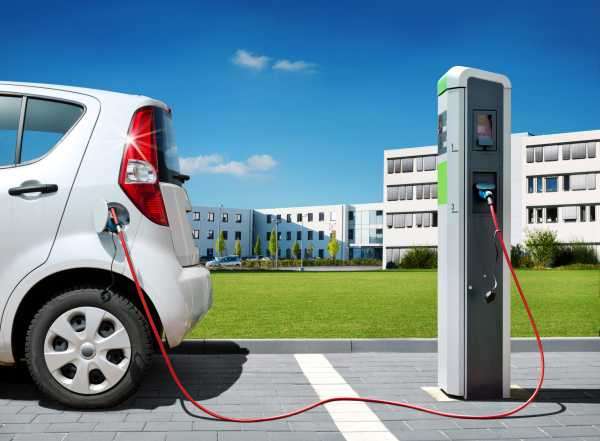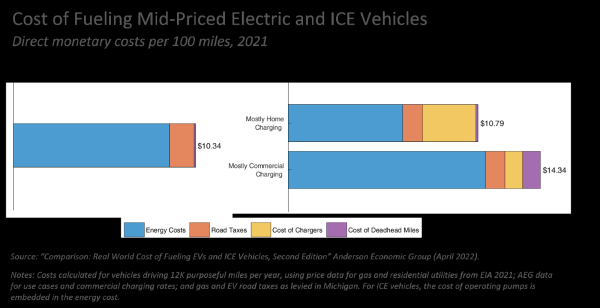
A recurrent trope in American politics is that affluent liberals like electric vehicles, vote for politicians who subsidize them, and want the government to order companies to build them. As a result, many conservatives have an almost visceral reaction against E.V.s.
We at the Anderson Economic Group argue that conservatives should neither love nor hate E.V.s. Instead, they should insist on a powerful principle: those who purchase and drive E.V.s should do so with their own money. If you really want to form public opinion, one of the most powerful weapons is also one of the simplest: let people see how much something costs.
Advertisement
Michael Fumento recently remarked in this publication on conservatives’ almost reflexive aversion to E.V.s. He argues this is a mistake, and that E.V.s have advantages that should be acknowledged. We agree that unthinking antipathy to any technology makes no sense. But Mr. Fumento makes the same error he sees in others, by equating the Anderson Economic Group’s comparative cost analyses with the advocacy journalism that promotes E.V.s. As a co-author of those reports, I want to underline our guiding principle: we neither push people to buy E.V.s nor criticizing them for doing so. Instead, we tell people how much they cost.
Anderson Economic Group’s recent EV study identifies four categories of fueling costs for both E.V.s and internal combustion engine (ICE) vehicles: the energy (gasoline, diesel, or electricity); the excise taxes charged for roads; the cost of a pump or charger; and the cost of driving to a gas station or charging station. Americans are quite familiar with these costs for gas- and diesel-powered vehicles. They are also accustomed to paying road taxes as part of the per-gallon price of gasoline or diesel fuel.
The same cannot be said for EVs. The true cost to fuel EVs is opaque to most consumers, because:
First, E.V. drivers must consider the cost of the energy consumed from both home and commercial charging. This requires decomposing energy consumption by charging source while accounting for complicated tariffs and fees.
Second, consumers must add the cost of the charger and its installation if they intend to charge at home.
Advertisement
Third, electric vehicle owners avoid paying the federal road taxes charged on fuel. However, half of all U.S. states now require a special E.V. tax in lieu of the state road taxes included in the cost of gasoline and diesel fuel.
Fourth, drivers must travel to and from E.V. charging stations, especially when traveling away from their home area. Because these are far less ubiquitous than gas stations, the additional miles required cost both time and money.
Fifth, many E.V. users consider their charging “free” because some commercial charging is subsidized by government agencies, utilities, and businesses. However, electricity and charging equipment are clearly not “free,” and consumers need to understand how they pay for this service.
The AEG reports carefully add and compare each of these categories, apples-to-apples, for both types of vehicles. Once hidden costs are included, we find that the cost to fuel E.V.s is often more, not less, than comparable ICE vehicles. Indeed, in 2021 a typical mid-priced E.V. cost slightly more, and a luxury E.V. less, to fuel than comparable ICE cars.
For example, a consumer driving a mid-priced EV about 12,000 miles a year who obtained most of his energy at home paid about $10.34 in fueling costs to drive 100 miles. Counting the same costs, a similar ICE vehicle cost approximately $10.79. For E.V. drivers reliant upon commercial chargers—e.g., those who travel extensively and those who cannot charge at home—the cost was closer to $14.34 per 100 miles.

Subscribe Today Get weekly emails in your inbox Email Address:
This shouldn’t be surprising. Charging and fueling equipment costs money; electricity and gasoline are not free; and roads cost a lot to build and maintain. Driving either an E.V. or an ICE vehicle means incurring all the above costs.
Conservatives should welcome exercises like the Anderson Economic Group studies that reveal the true cost of important consumer goods. We should also insist that the government stop subsidizing one class of buyers at the expense of others. In this, we can join liberals in an obvious demand: stop subsidizing auto purchases with incentives that heavily benefit the wealthy. It should be jarring to see that 78 percent of the federal EV tax credits have gone to Americans with incomes over $100,000. This means taxpayers who walk, bike, drive old used cars, or use public transportation foot part of the bill for high-priced E.V.s purchased by affluent households. There is no public policy justification for this.
Americans should be given more facts—and less guilt—when making car-buying decisions. To that end, the Anderson Economic Group encourages readers to access our full report and learn about the actual costs of driving E.V.s and ICE vehicles. We do not censor our results to match the political winds of the day. Instead, we provide taxpayers and consumers with information that empowers them to decide for themselves.
Advertisement
Sourse: theamericanconservative.com






